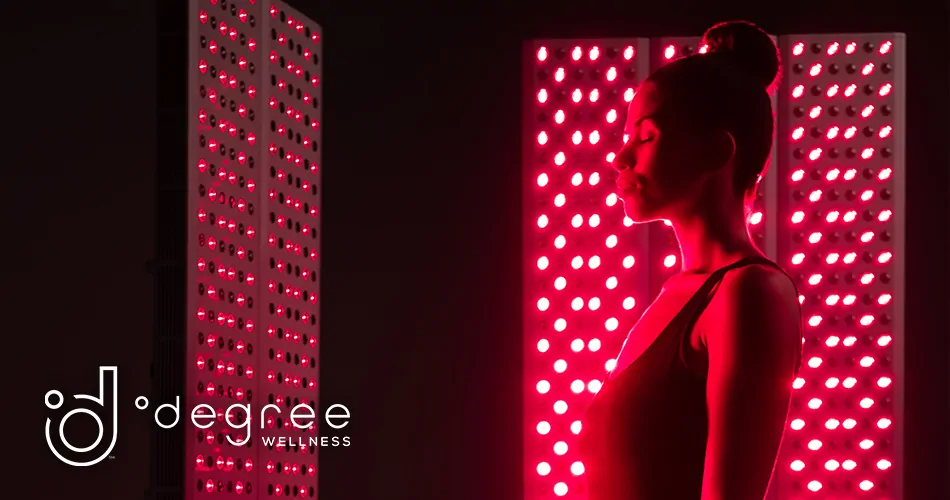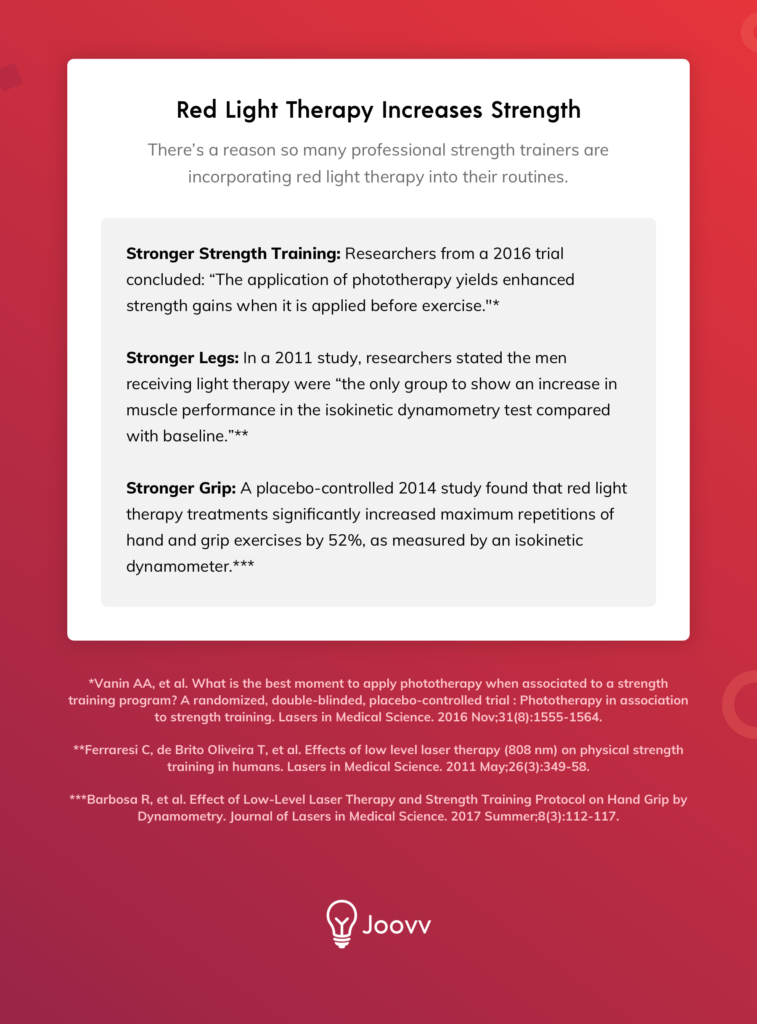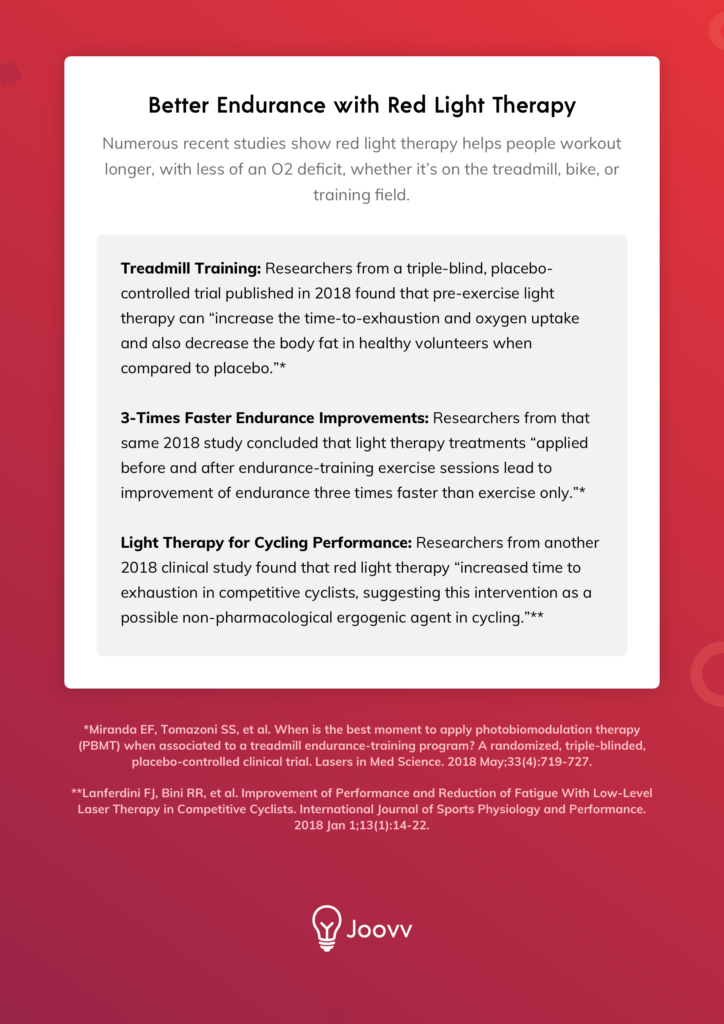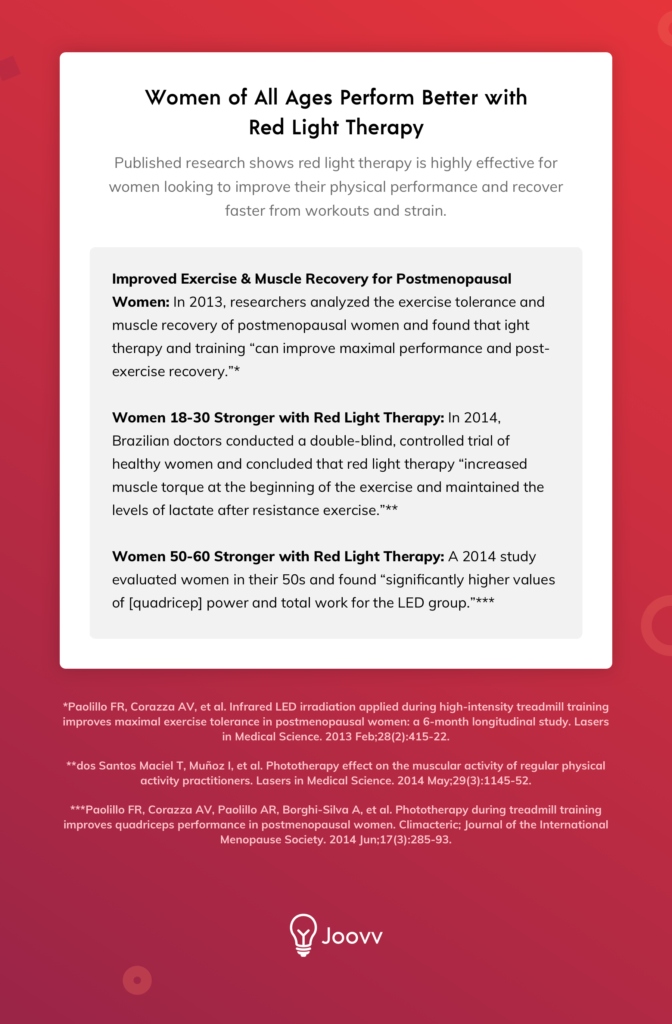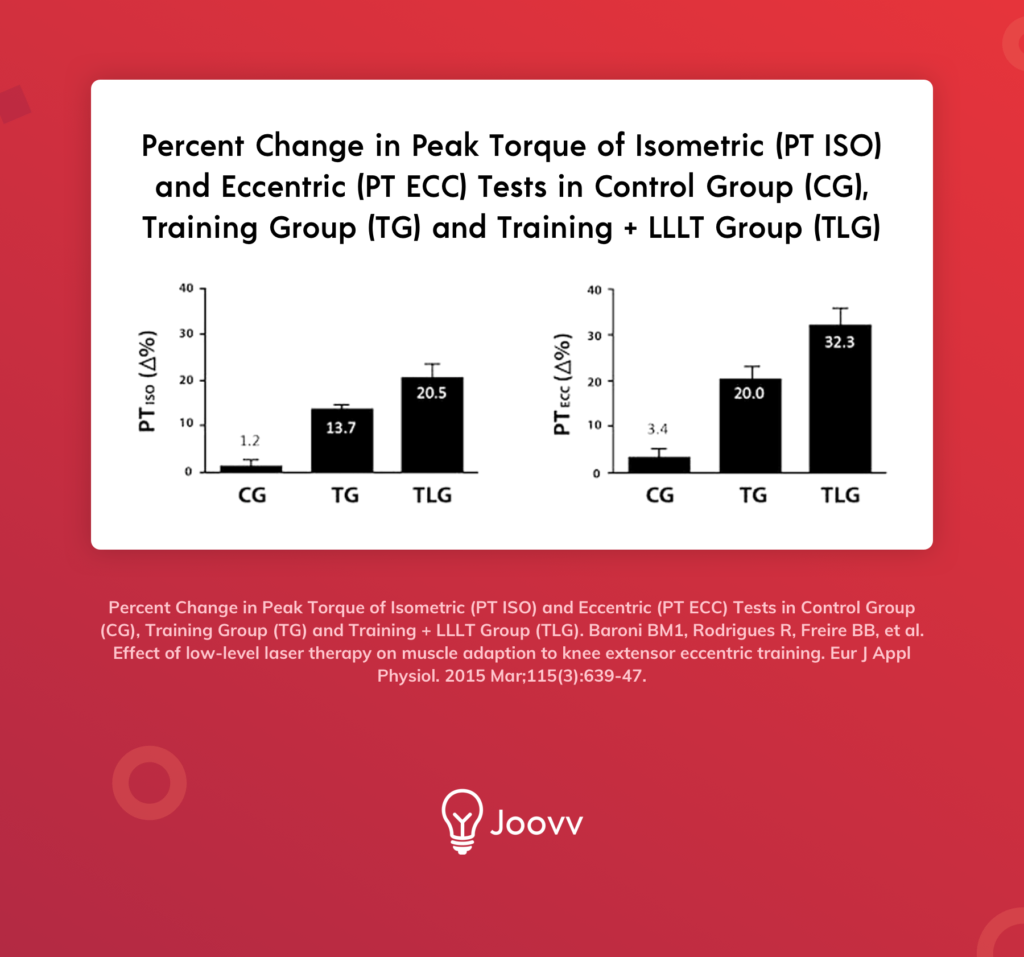Red light therapy, especially Joovv, is popular in professional sports and the training & fitness worlds because it’s been proven again and again to enhance physical performance, build muscle, and speed up recovery. This has been shown scientifically across hundreds of peer-reviewed clinical trials, and it’s shown anecdotally on fields and gyms, where NBA teams, UFC champions, gold medalists, and NFL all-pros like Patrick Peterson, DeMarcus Lawrence, and Keenan Allen are using Joovv every day for peak performance and faster muscle recovery. The same is true of world-class trainers and fitness experts like Ben Greenfield, Dr. Sarah Ballantyne (aka Paleo Mom), and many others.
This article breaks down the research and results on red light therapy and enhanced physical performance.
Huge Base of Clinical Research Shows Red Light Therapy Improves Physical Performance
Hundreds of peer-reviewed studies have been published on red light therapy’s positive effects on exercise, training, and specific areas of physical performance like strength, speed, and endurance. In 2015, researchers performed a systematic review and meta-analysis of many of these randomized, placebo-controlled trials. The results were overwhelmingly positive:
- The vast majority of clinical trials reviewed showed “significant improvement for the main measures related to performance” like max repetitions, speed, and endurance.
- Time before exhaustion during various exercises “increased significantly compared to placebo.”
- Researchers concluded that “phototherapy (with lasers and LEDs) improves muscular performance and accelerates recovery when applied before exercise.” [1]
Now, we’ll take a closer look at specific research showing how red light therapy boosts strength, speed, endurance, and muscle growth.
How Red Light Therapy Increases Strength
There’s a reason so many professional strength trainers are incorporating red light therapy into their routines.
Stronger Strength Training: A 2016 trial analyzed light therapy’s effects on men ages 18 to 35 who did strength training. Men in the light therapy group “showed significant changes” in max torque for both leg extension and leg press exercises.
Researchers concluded: “The application of phototherapy yields enhanced strength gains when it is applied before exercise. The application may have additional beneficial value in post-injury rehabilitation where strength improvements are needed.” [2] In 2011, researchers testing light therapy and strength training on healthy young men concluded: “Strength training associated with light therapy can increase muscle performance compared with strength training only.” [3]
Stronger Legs: That aforementioned increase amounted to a 55% increase in leg-press tests, far higher than the non-therapy group. The men receiving light therapy were “the only group to show an increase in muscle performance in the isokinetic dynamometry test compared with baseline.” [3]
Stronger Grip: A placebo-controlled 2014 study found that red light therapy treatments significantly increased maximum repetitions of hand and grip exercises by 52%, as measured by an isokinetic dynamometer. [4] Numerous other studies have also shown significant grip strength increases during exercise after light therapy treatments. [5]
Is Joovv an “Unfair Competitive Advantage”?
One of the best strength trainers of all-time, the late great strength trainer Charles Poliquin, told us that he had all his clients using Joovv red light therapy for training performance, energy, and muscle recovery. He also mentioned that people in the training and sports worlds have a new dilemma: red light therapy seems to be giving athletes an “unfair competitive advantage”—almost like a performance-enhancing drug, even though red light therapy is completely natural. Advantage? Yes! Unfair or unnatural? Definitely not.
Better Endurance with Red Light Therapy
Numerous recent studies show red light therapy helps people workout longer, with less of an oxygen deficit, whether it’s on the treadmill, bike, or training field. These are recent clinical results in published, peer-reviewed trials from around the world:
Treadmill Training: A triple-blind, placebo-controlled trial published in 2018 evaluated red light therapy’s effects on healthy men and women who were also going through endurance training on treadmills. Researchers found that pre-exercise light therapy can “increase the time-to-exhaustion and oxygen uptake and also decrease the body fat in healthy volunteers when compared to placebo.” [6]
3-Times Faster Endurance Improvements: Researchers concluded that light therapy treatments “applied before and after endurance-training exercise sessions lead to improvement of endurance three times faster than exercise only.” [6]
Powering Professional Soccer Players: Futsal is an indoor variation of international soccer that’s played on a smaller field, with a rapid back-and-forth pace similar to basketball or hockey. The professional level requires incredible endurance. In 2018, Brazilian researchers conducted a randomized, triple-blinded, placebo-controlled trial to analyze the effects of red light therapy treatments on pro futsal players. Players were treated with red light therapy or placebo light before matches.
Researchers found that the red light therapy group was clearly able to stay on the field longer. They concluded that light therapy “significantly increased the time of staying in the pitch and had a significant improvement in all the biochemical markers evaluated…pre-exercise therapy can enhance performance and accelerate recovery of high-level futsal players.” [7]
Light Therapy for Cycling Performance: The recent results of the Brazilian futsal trial align with two other recent trials conducted on light therapy and peak cycling performance. Researchers found that red light therapy “increased time to exhaustion in competitive cyclists, suggesting this intervention as a possible non-pharmacological ergogenic agent in cycling.” [8]
The same research team performed a follow-up trial to test the VO2 kinetics of athletes during cycling tests, and found similar positive results: red light therapy “decreases O2 deficit during time-to-exhaustion tests in competitive cyclists, and these changes in VO2 kinetics response can be one of the possible mechanisms to explain the ergogenic effect induced by light therapy.” [9]
Enhanced Speed with Red Light Therapy
Red light therapy significantly improves running performance as well.
Faster, More Efficient Running: In 2018, researchers in Brazil published a randomized, double-blind, placebo-controlled study that tested male running performance in 3 groups: men receiving red light therapy treatments, plus a placebo and a control group that did not receive red light therapy.
The highest performing group was easily the light therapy group, which saw “significantly improved running economy, rate of perceived exertion, velocity, peak of velocity, and total time to exhaustion, compared with placebo.” [10]
Faster Sprints: A 2016 study of professional rugby players assessed numerous markers of physical performance, and found light therapy treatments led to faster running, in addition to major muscle recovery benefits. Light therapy “significantly improved the average time of sprints.” [11]
Women of All Ages Perform Better with Red Light Therapy
Several of the studies mentioned so far analyzed the physical performance of male athletes, but clinical research is just as positive for women of all ages and fitness levels. The published research shows red light therapy is highly effective for women looking to improve their physical performance and recover faster from workouts and strain.
Improved Exercise & Muscle Recovery for Postmenopausal Women: In 2013, researchers analyzed the exercise tolerance and muscle recovery of 30 postmenopausal women over the course of 6 months. One group received near-infrared light therapy and went through treadmill training, while the other group just did the treadmill work. Researchers found:
- “Time of recovery showed a significant decrease only in the LED group.”
- “Differences before and after training for the Tlim (max exercise tolerance time), METs (metabolic equivalents) and maximal heart rate at isotime were greater in the LED group than in the exercise group with a significant intergroup difference.”
- Light therapy and training “can improve maximal performance and post-exercise recovery in postmenopausal women.” [12]
Women 18-30 Stronger with Red Light Therapy: In 2014, Brazilian doctors conducted a double-blind, controlled trial of healthy women ages 18 to 30 who did leg exercises with or without red light therapy. Their published report found “significant torque increase (p < 0.05) post-light therapy,” compared to the placebo group.
They concluded that red light therapy “increased muscle torque at the beginning of the exercise and maintained the levels of lactate after resistance exercise. Therefore, light therapy with these parameters…can be utilized in rehabilitation to improve muscle performance.” [13]
Women 50-60 Stronger with Red Light Therapy: A 2014 study evaluated women in their 50s and found “significantly higher values of (quadricep) power and total work for the LED group.” Fatigue was also significantly lower in the LED group. [14]
Elite Women Athletes are Using Joovv Red Light Therapy
Lauren Fendrick is one of the best beach volleyball players in the world. Lauren competed in Rio in 2016, and has her eyes set on 2020 in Tokyo. She told Joovv her biggest lesson learned from competing on the international stage was that she needed to focus more on recovery. Now Joovv is helping her come back from workouts faster with less injury risk.
Amelia Boone is one of the most decorated obstacle racers of all-time (in her spare time from being a full-time attorney). Amelia tried Joovv red light therapy for rehab after spraining ligaments in her forefoot. She says Joovv made a huge difference and that light therapy is absolutely clutch for muscle recovery and rehab.
Natural Health & Fitness Leaders Too: Dr. Sarah Ballantyne, aka Paleo Mom, studied the clinical research on red light therapy, gave Joovv a try, and saw a big difference in her workout performance and muscle recovery. Dr. Sarah says:
“I love using my Joovv after my Crossfit workouts because the natural red light has a proven regenerative effect on muscle tissue. My Joovv feels really warm and pleasant after a training session and I have way less soreness. A lot of professional athletes, trainers, and endurance competitors are using red light therapy now to gain a natural competitive advantage and I expect that trend to continue as more people learn about the muscle health benefits.”*
Red Light Therapy for Enhanced Muscle Growth
In addition to improving physical performance across a wide range of people and exercises, research also shows red light therapy can enhance muscle growth too.
More Muscle Activity, Less Fatigue: A 2010 trial published in Photomedicine and Laser Surgery analyzed red light therapy and muscle performance, with both men and women. In the red light therapy group, the authors noted “an increase in muscle activity” and “a significant increase in the time before fatigue was observed.”
Researchers determined light therapy “can be used as a clinical tool to increase muscle activity (1.044 J per point) and to prevent fatigue (2.088 J per point).” [15]
Light Therapy Increases Muscle Size & Bulk: Research in the American Journal of Physical Medicine and Rehabilitation has found light therapy also promotes the growth of healthy muscle tissue, or muscle hypertrophy, naturally increasing muscle size and bulk—as well as strength. [16,17]
A separate study in the European Journal of Applied Physiology compared muscle growth and strength between two groups of athletes—one using light therapy combined with exercise, the other using exercise alone—and found that muscle thickness and strength were significantly improved (by over 50%) in those who used light therapy. These results were clearly measurable using ultrasound imaging and isokinetic dynamometry, as shown in the graph below. [18]
Summary: Perform Better and Recovery Faster with Red Light Therapy
In trial after trial, men and women of all ages, body types, and fitness levels are showing major physical performance improvements when combining red light therapy use with exercise. The clinical results match what world-class pro athletes and trainers are seeing on the field and in the gym every day. If you’re looking for a natural physical performance boost, red light therapy is getting big results. For elite athletes like Patrick Peterson, Lauren Fendrick, and TJ Dillashaw, and for regular weekend warriors trying to get in better shape, look good, and show something extra in the intramural league or pickup game.
Scientific Sources and Medical References:
[1] Leal-Junior EC, Vanin AA, et al. Effect of phototherapy (low-level laser therapy and light-emitting diode therapy) on exercise performance and markers of exercise recovery: a systematic review with meta-analysis. Lasers in Medical Science. 2015 Feb;30(2):925-39.
[2] Vanin AA, et al. What is the best moment to apply phototherapy when associated to a strength training program? A randomized, double-blinded, placebo-controlled trial : Phototherapy in association to strength training. Lasers in Medical Science. 2016 Nov;31(8):1555-1564.
[3] Ferraresi C, de Brito Oliveira T, et al. Effects of low level laser therapy (808 nm) on physical strength training in humans. Lasers in Medical Science. 2011 May;26(3):349-58.
[4] de Brito Vieira WH, Bezerra RM, et al. Use of low-level laser therapy (808 nm) to muscle fatigue resistance: a randomized double-blind crossover trial. Photomedicine and Laser Surgery. 2014 Dec;32(12):678-85.
[5] Barbosa R, et al. Effect of Low-Level Laser Therapy and Strength Training Protocol on Hand Grip by Dynamometry. Journal of Lasers in Medical Science. 2017 Summer;8(3):112-117.
[6] Miranda EF, Tomazoni SS, et al. When is the best moment to apply photobiomodulation therapy (PBMT) when associated to a treadmill endurance-training program? A randomized, triple-blinded, placebo-controlled clinical trial. Lasers in Med Science. 2018 May;33(4):719-727.
[7] De Marchi T, Leal-Junior ECP, et al. Photobiomodulation therapy before futsal matches improves the staying time of athletes in the court and accelerates post-exercise recovery. Lasers in Medical Science. 2018 Sep 27
[8] Lanferdini FJ, Bini RR, et al. Improvement of Performance and Reduction of Fatigue With Low-Level Laser Therapy in Competitive Cyclists. International Journal of Sports Physiology and Performance. 2018 Jan 1;13(1):14-22.
[9] Lanferdini FJ, Krüger RL, et al. Low-level laser therapy improves the VO2 kinetics in competitive cyclists. Lasers in Medical Science. 2018 Apr;33(3):453-460.
[10] Dellagrana RA, Rossato M, et al. Photobiomodulation Therapy on Physiological and Performance Parameters During Running Tests: Dose-Response Effects. Journal of Strength and Conditioning Research. 2018 Oct;32(10):2807-2815.
[11] Pinto HD, Vanin AA, et al. Photobiomodulation Therapy Improves Performance and Accelerates Recovery of High-Level Rugby Players in Field Test: A Randomized, Crossover, Double-Blind, Placebo-Controlled Clinical Study. Journal of Strength and Conditioning Research. 2016 Dec;30(12):3329-3338.
[12] Paolillo FR, Corazza AV, et al. Infrared LED irradiation applied during high-intensity treadmill training improves maximal exercise tolerance in postmenopausal women: a 6-month longitudinal study. Lasers in Medical Science. 2013 Feb;28(2):415-22.
[13] dos Santos Maciel T, Muñoz I, et al. Phototherapy effect on the muscular activity of regular physical activity practitioners. Lasers in Medical Science. 2014 May;29(3):1145-52.
[14] Paolillo FR, Corazza AV, Paolillo AR, Borghi-Silva A, et al. Phototherapy during treadmill training improves quadriceps performance in postmenopausal women. Climacteric; Journal of the International Menopause Society. 2014 Jun;17(3):285-93.
[15] Kelencz CA, Muñoz IS, etc. Effect of low-power gallium-aluminum-arsenium noncoherent light (640 nm) on muscle activity: a clinical study.
[16] Halliwell B, Gutteridge JC. Free radicals in biology and medicine. Oxford: Oxford University Press; 2000.
[17] Ferraresi C, Bertucci D, Schiavinato J, et al. Effects of Light-Emitting Diode Therapy on Muscle Hypertrophy, Gene Expression, Performance, Damage, and Delayed-Onset Muscle Soreness: Case-control Study with a Pair of Identical Twins. Am J Phys Med Rehabil. 2016 Oct;95(10):746-57.
[18] Baroni BM1, Rodrigues R, Freire BB, et al. Effect of low-level laser therapy on muscle adaptation to knee extensor eccentric training. Eur J Appl Physiol. 2015 Mar;115(3):639-47.

